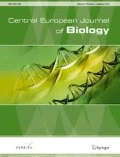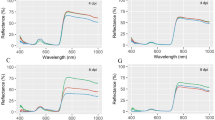Abstract
The ability to identify diseases in an early infection stage and to accurately quantify the severity of infection is crucial in plant disease assessment and management. A greenhouse study was conducted to assess changes in leaf spectral reflectance of wheat plants during infection by powdery mildew and take-all disease to evaluate leaf reflectance measurements as a tool to identify and quantify disease severity and to discriminate between different diseases. Wheat plants were inoculated under controlled conditions in different intensities either with powdery mildew or take-all. Leaf reflectance was measured with a digital imager (Leica S1 Pro, Leica, Germany) under controlled light conditions in various wavelength ranges covering the visible and the near-infrared spectra (380–1300 nm). Leaf scans were evaluated by means of L*a*b*-color system. Visual estimates of disease severity were made for each of the epidemics daily from the onset of visible symptoms to maximum disease severity. Reflectance within the ranges of 490780 nm (r2 = 0.69), 510780nm (r2 = 0.74), 5161300nm (r2 = 0.62) and 5401300 nm (r2 = 0.60) exhibited the strongest relationship with infection levels of both powdery mildew and take-all disease. Among the evaluated spectra the range of 490780nm showed most sensitive response to damage caused by powdery mildew and take-all infestation. The results of this study indicated that disease detection and discrimination by means of reflectance measurements may be realized by the use of specific wavelength ranges. Further studies have to be carried out, to discriminate powdery mildew and take-all infection from other plant stress factors in order to develop suitable decision support systems for site-specific fungicide application.
Similar content being viewed by others
References
J.N. Perry: “Sampling and applied statistics for pests and diseases. Sampling to make decisions”, Aspects Appl. Biol., Vol. 37, (1994), pp. 1–14.
G. Hughes: “Incorporating spatial pattern of harmful organisms into crop loss models”, Crop Protect., Vol. 15, (1996), pp. 407–421.
H.A. McCartney and B.D.L. Fitt: “Dispersal of foliar fungal plant pathogens: mechanisms, gradients and spatial patterns”, in D. Gareth Jones (Ed.): Plant disease epidemiology, Kluwer Publishers, London, 1998, pp. 138–160.
Y. Sasaki, T. Okamoto, K. Imou and T. Torii: “Automatic diagnosis of plant disease — Spectral reflectance of healthy and diseased leaves”, In: Proc. AgEng98 International Conference on Agricultural Engineering, Oslo (Norway), 1998, CD.
B. Lorenzen and A. Jensen: “Changes in spectral properties induced in barley by cereal powdery mildew”, Rem. Sens. Environ., Vol. 27, (1989), pp. 201–209.
B.J.M. Secher: “Site specific control of diseases in winter wheat”, Aspects Appl. Biol., Vol. 48, (1997), pp. 58–64.
F.W. Nutter (Jr.), M.L. Gleason, J.H. Jenco and N.C. Christians: “Assessing the accuracy, inter-rater repeatability and inter-rater reliability of disease assessment systems”, Phytopathology, Vol. 83, (1993), pp. 806–812.
L.D. Lathrop and S. Pennypacker: “Spectral classification of tomato disease severity levels”, Photogramm. Eng. Rem. Sens., Vol. 46, (1980), pp. 1433–1438.
F.W. Nutter (Jr.): “Detection and measurement of plant disease gradients in peanut with a multispectral radiometer”, Phytopathology, Vol. 79, (1989), pp. 958–963.
H. E. Nilsson: “Hand-held radiometry and IR thermography of plant diseases in field plot experiments”, Int. J. Rem. Sens., Vol. 12, (1991), pp. 545–557.
L. Chaerle, W.M. Van Caeneghem, H. Lambers, M. Van Montagu and D. Van Der Straeten: “Presymptomatic visualization of plant-virus interactions by thermography”, Nat. Biotechnol., Vol. 17, (1999), pp. 813–816.
L. Chaerle and D. Van der Straeten: “Seeing is believing: imaging techniques to monitor plant health”, Biochim. Biophys. Acta, Vol. 1519, (2001), pp. 153–166.
J.R. Riley: “Remote sensing in entomology”, Annu. Rev. Entomol., Vol. 34, (1989), pp. 247–271.
J.L. Hatfield and P.J. Pinter: “Remote sensing for crop protection”, Crop Protect., Vol. 12, (1993), pp. 403–413.
M.S. Moran, Y. Inoue and E.M. Barnes: “Opportunities and limitations for image-based remote sensing in precision crop management”, Rem. Sens. Environ., Vol. 61, (1997), pp. 319–346.
H.E. Nilsson: “Remote sensing and image analysis in plant pathology”, Can. J. Plant Pathol., Vol. 17, (1995a), pp. 154–166.
D.M. Gates, H.J. Keegan, J.C. Schleter and V.R. Weidner: “Spectral properties of plants”, Appl. Optics, Vol. 4, (1965), pp. 11–20.
H.E. Nilsson: “Remote sensing and image analysis in plant pathology”, Annu. Rev. Phytopath., Vol. 15, (1995), pp. 489–527.
H.E. Nilsson: Application of remote sensing methods and image analysis at macroscopic and microscopic levels, Miscellaneous Publication 7, University of Minnesota Agricultural Experiment Station, St. Paul, 1980.
J.J. Burdon: Diseases and Plant Population Biology, Cambridge University Press, Cambridge, 1987.
N.D. Paul and P.G. Ayres: “Effects of rust and post-infection drought on photosynthesis, growth, and water relations in groundsel”, Plant Pathol., Vol. 33, (1984), pp. 561–569.
N.D. Paul and P.G. Ayres: “Water stress modifies intraspecific interference between rust (Puccinia lagenophorae Cooke) — infected and healthy groundsel (Senecio vulgaris L.)”, New Phytol., Vol. 106, (1987), pp. 555–566.
G.M. Murray and J.F. Brown: “The incidence and relative importance of wheat diseases in Australia”, Australas. Plant Pathol., Vol. 16, (1987), pp. 34–37.
J.P. Brennan and G.M. Murray: “Australian wheat diseases: assessing their economic importance”, J. Agr. Sci., Vol. 2, (1988), pp. 26–35.
S. Graeff, D. Steffens and S. Schubert: “Use of reflectance measurements for the early detection of N, P, Mg, and Fe deficiencies in Zea mays L.”, J. Plant Nutr. Soil Sci., Vol. 164, (2001), pp. 445–450.
S. Graeff and W. Claupein: “Quantifying nitrogen status of corn (Zea mays L.) in the field by reflectance measurements”, Eur. J. Agron., Vol. 19, (2003), pp. 611–618.
P.D. Lancashire, H. Bleiholder, T. van den Boom, P. Langelüddeke, R. Strauss, E. Weber and A. Witzenberger: “A uniform decimal code for growth stages of crops and weeds”, Ann. Appl. Biol., Vol. 119, (1991), pp. 561–601.
S. Graeff: Früherkennung von Ernährungsstörungen bei Zea mays L. mittels Blatt-Reflexionsmessungen, Thesis (PhD), University of Gießen, 2000.
CIE: Colorimetry, 2nd ed., Publication CIE No. 15.2, Commission Internationale de ls’Éclairage, Vienna, 1986.
BSA: Richtlinien für die Durchführung von landwirtschaftlichen Wertprüfungen und Sortenversuchen, Verlag Alfred Strothe, Frankfurt a.M., 1988.
S.E. Allen: Chemical analysis of ecological materials, 2nd ed., Blackwell Scientific Publications, Oxford, 1989.
A. Dumas: “Stickstoffbestimmung nach Dumas”, Die Praxis des organischen Chemikers, Vol. 41, (1962), pp. 45–51.
J.C. Deguise and H. McNairn: “Hyperspectral remote sensing for precision agriculture”, In: Proceedings of Fifth International Conference on Precision Agriculture, Bloomington (USA), 2000, CD.
T.J. Malthus and A.C. Madeira: “High resolution spectroradiometry: Spectral reflectance of field bean leaves infected by Botrytis fabae”, Rem. Sens. Environ., Vol. 45, (1993), pp. 107–116.
V.P. Polischuk, T.M. Shadchina, T.I. Kompanetz, I.G. Budzanivskaya and A.A. Sozinov: “Changes in reflectance spectrum characteristic of Nicotiana debneyi plant under the influence of viral infection”, Arch. Phytopath. Plant Protect., Vol. 31(1), (1997), pp. 115–119.
J.G. Hansen: “Use of multispectral radiometry in wheat yellow rust experiments”, Bull. EPPO, Vol. 21, (1991), pp. 651–658.
H.E. Nilsson and L. Johnsson: “Hand-held radiometry of barley infected by barley stripe disease in a field experiment”, J. Plant Dis. Protect., Vol. 103, (1996), pp. 517–526.
F.W. Nutter (Jr.) and R.H. Littrell: “Relationships between defoliation, canopy reflectance and pod yield in the peanut-late leafspot pathosystem”, Crop Protect., Vol. 15, (1996), pp. 135–142.
F.W. Nutter (Jr.), R.H. Littrell and T.B. Brenneman: “Utilization of a multispectral radiometer to evaluate fungicide efficacy to control late leaf spot in peanut”, Phytopath., Vol. 80, (1990), pp. 102–108.
G. Guyot: “Optical properties of vegetation canopies”, In: M.D. Steven and J.A. Clark (Eds.): Applications of Remote Sensing in Agriculture, Butterworths, London, 1990, pp. 19–43.
L. Grant: “Diffuse and specular characteristics of leaf reflectance”, Rem. Sens. Environ., Vol. 22, (1987), pp. 309–322.
Author information
Authors and Affiliations
About this article
Cite this article
Graeff, S., Link, J. & Claupein, W. Identification of powdery mildew (Erysiphe graminis sp. tritici) and take-all disease (Gaeumannomyces graminis sp. tritici) in wheat (Triticum aestivum L.) by means of leaf reflectance measurements. cent.eur.j.biol. 1, 275–288 (2006). https://doi.org/10.2478/s11535-006-0020-8
Received:
Accepted:
Issue Date:
DOI: https://doi.org/10.2478/s11535-006-0020-8




